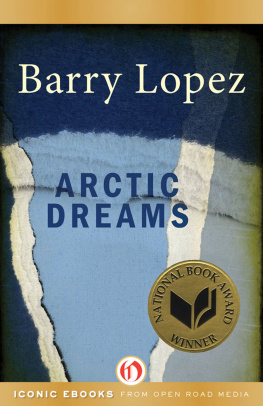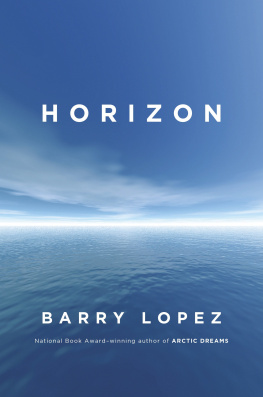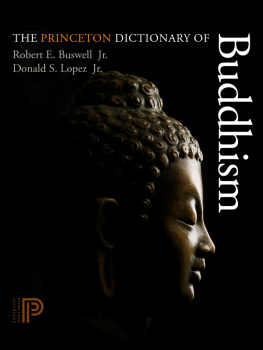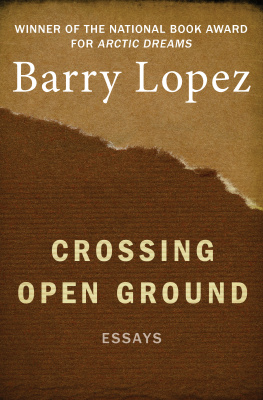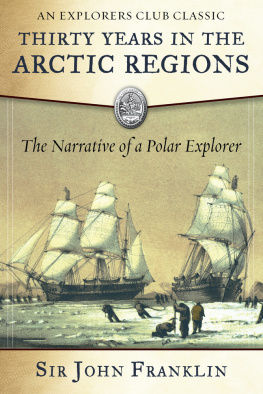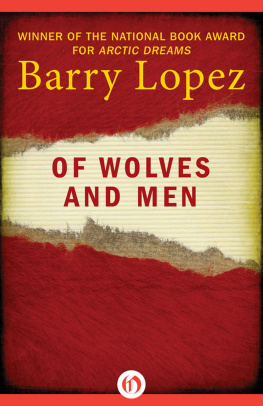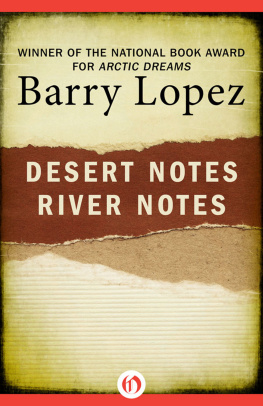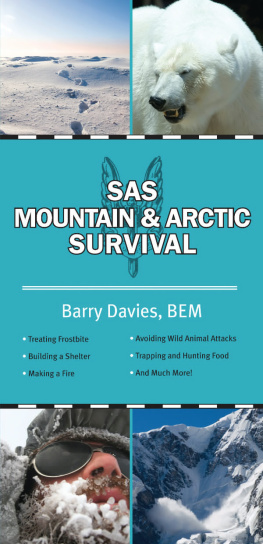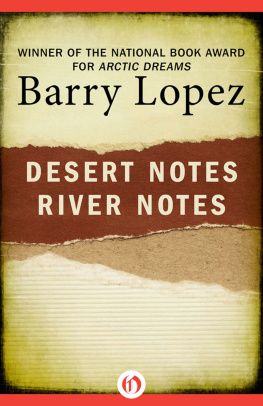
Arctic Dreams
Imagination and Desire in a Northern Landscape
Barry Lopez
For Sandra
The landscape conveys an impression of absolute permanence. It is not hostile. It is simply thereuntouched, silent and complete. It is very lonely, yet the absence of all human traces gives you the feeling you understand this land and can take your place in it.
EDMUND CARPENTER
Once in his life a man ought to concentrate his mind upon the remembered earth. He ought to give himself up to a particular landscape in his experience; to look at it from as many angles as he can, to wonder upon it, to dwell upon it.
He ought to imagine that he touches it with his hands at every season and listens to the sounds that are made upon it.
He ought to imagine the creatures there and all the faintest motions of the wind. He ought to recollect the glare of the moon and the colors of the dawn and dusk.
N. SCOTT MOMADAY
Authors Note
THE SCIENTIFIC NAMES OF northern animals and plants, and geographic coordinates for named places in the North, are listed in the appendices. Bibliographic information is in the text itself, in footnotes, in the Notes section beginning on , depending on where its appearance is most appropriate. Maps in the Maps section are cartographically accurate. Maps in the text are mostly simplified sketches and not drawn to scale. Eskimo terms, unless otherwise noted, are from the Inuktitut dialects of the eastern Canadian Arctic. Eskimo words in common English usage, such as iglu (house), kayak, and qamutiik (sledge) are not italicized.
Preface
BEYOND A REGARD FOR THE landscape itself, this book finds its origin in two moments.
One summer evening I was camped in the western Brooks Range of Alaska with a friend. From the ridge where we had pitched our tent we looked out over tens of square miles of rolling tundra along the southern edge of the calving grounds of the Western Arctic caribou herd. During those days we observed not only caribou and wolves, which wed come to study, but wolverine and red fox, ground squirrels, delicate-legged whimbrels and aggressive jaegers, all in the unfoldings of their obscure lives. One night we watched in awe as a young grizzly bear tried repeatedly to force its way past a yearling wolf standing guard alone before a den of young pups. The bear eventually gave up and went on its way. We watched snowy owls and rough-legged hawks hunt and caribou drift like smoke through the valley.
On the evening I am thinking aboutit was breezy there on Ilingnorak Ridge, and cold; but the late-night sun, small as a kite in the northern sky, poured forth an energy that burned against my cheekbonesit was on that evening that I went on a walk for the first time among the tundra birds. They all build their nests on the ground, so their vulnerability is extreme. I gazed down at a single horned lark no bigger than my fist. She stared back resolute as iron. As I approached, golden plovers abandoned their nests in hysterical ploys, artfully feigning a broken wing to distract me from the woven grass cups that couched their pale, darkly speckled eggs. Their eggs glowed with a soft, pure light, like the window light in a Vermeer painting. I marveled at this intense and concentrated beauty on the vast table of the plain. I walked on to find Lapland longspurs as still on their nests as stones, their dark eyes gleaming. At the nest of two snowy owls I stopped. These are more formidable animals than plovers. I stood motionless. The wild glare in their eyes receded. One owl settled back slowly over its three eggs, with an aura of primitive alertness. The other watched me, and immediately sought a bond with my eyes if I started to move.
I took to bowing on these evening walks. I would bow slightly with my hands in my pockets, toward the birds and the evidence of life in their nestsbecause of their fecundity, unexpected in this remote region, and because of the serene arctic light that came down over the land like breath, like breathing.
I remember the wild, dedicated lives of the birds that night and also the abandon with which a small herd of caribou crossed the Kokolik River to the northwest, the incident of only a few moments. They pranced through like wild mares, kicking up sheets of water across the evening sun and shaking it off on the far side like huge dogs, a bloom of spray that glittered in the air around them like grains of mica.
I remember the press of light against my face. The explosive skitter of calves among grazing caribou. And the warm intensity of the eggs beneath these resolute birds. Until then, perhaps because the sun was shining in the very middle of the night, so out of tune with my own customary perception, I had never known how benign sunlight could be. How forgiving. How run through with compassion in a land that bore so eloquently the evidence of centuries of winter.
During those summer days on Ilingnorak Ridge there was no dark night. Darkness never came. The birds were born. They flourished, and then flew south in the wake of the caribou.
The second incident is more fleeting. It occurred one night when I was being driven past a graveyard in Kalamazoo, Michigan. Among the gravestones was one marking the burial place of Edward Israel, a shy young man who sailed north in 1881 with Lieutenant Adolphus Greely. Greely and his men established a base camp on Ellesmere Island, 450 miles from the North Pole, and explored the surrounding territory in the spring of 1882. A planned relief expedition failed to reach them that summer, and also failed again the next year. Desperate, Greelys party of twenty-five retreated south, hopeful of being met by a rescue party in 1884. They wintered at Cape Sabine, Ellesmere Island, where sixteen of them died of starvation and scurvy, another committed suicide, and one man was executed for stealing food. Israel, the expeditions astronomer, died on May 27, 1884, three weeks before the others were rescued. The survivors remembered him as the most congenial person among them.
I remember looking out the back window of the car that evening and seeing Israels grave in the falling light. What had this man hoped to find? What sort of place did he think lay out there before him on that bright June morning in 1881 when the Proteus slipped its moorings at Saint Johns, Newfoundland?
No one is able to say, of course. He was drawn on by the fixations of his own imagination, as were John Davis and William Baffin before him and as Robert Peary and Vilhjalmur Stefansson would be after him. Perhaps he intended to make his mark as a scientist, to set his teeth in that high arctic landscape and come home like Darwin to a sedate and contemplative life, in the farmlands of southern Michigan. Perhaps he merely hungered after the unusual. We can only imagine that he desired something, the fulfillment of some personal and private dream, to which he pinned his life.
Israel was buried with great public feeling and patriotic rhetoric. His gravestone reads
IN LIFE A TRUE CHILD OF GOD
IN DEATH A HERO

These two incidents came back to me often in the four or five years that I traveled in the Arctic. The one, timeless and full of light, reminded me of sublime innocence, of the innate beauty of undisturbed relationships. The other, a dream gone awry, reminded me of the long human struggle, mental and physical, to come to terms with the Far North. As I traveled, I came to believe that peoples desires and aspirations were as much a part of the land as the wind, solitary animals, and the bright fields of stone and tundra. And, too, that the land itself existed quite apart from these.
Next page
